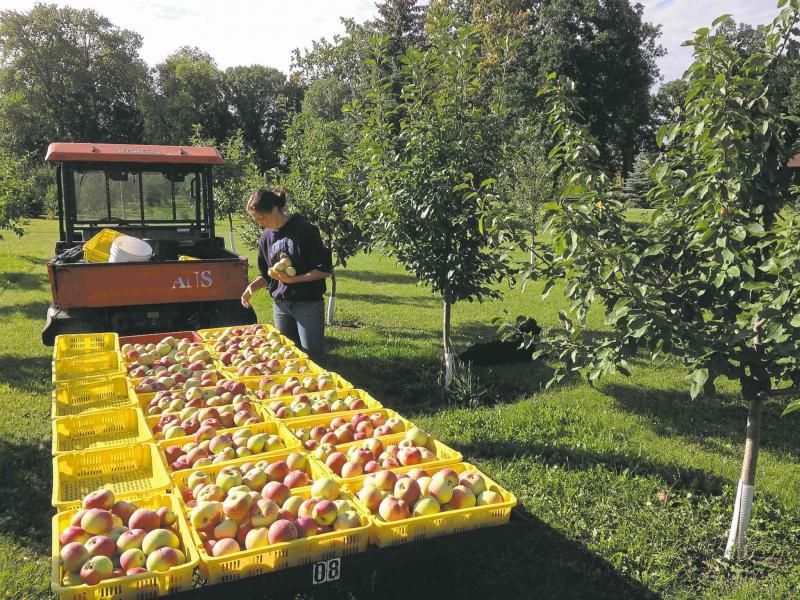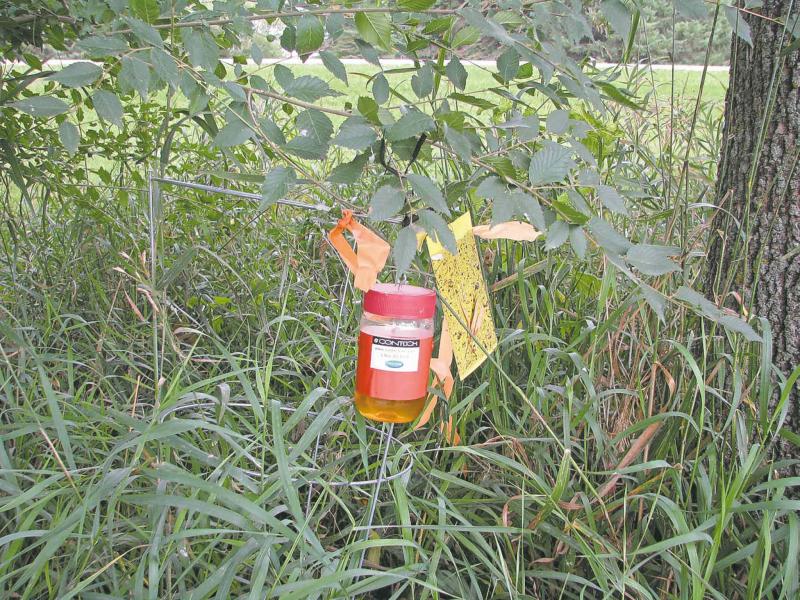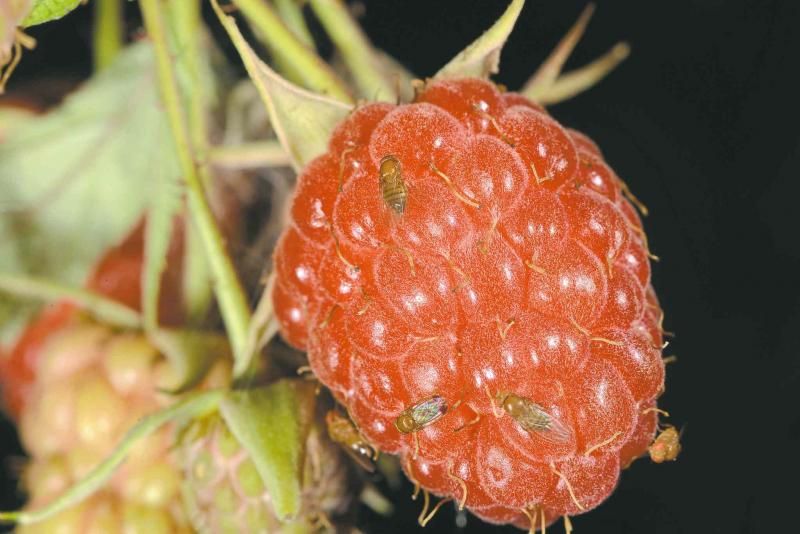

Growing a mix of small fruits in the garden alongside flowering plants infuses it with colour, flavour and diversity. Manitoba's legendary climate with its long, cold winters and hot, dry summers, as well as rich, clay soil has proven ideal for growing a wide range of fruits including apples, grapes, Highbush cranberries, saskatoon berries, and of course, strawberries and raspberries.
Whether you grow fruit in your backyard or line up at your local farmers' market to buy the fruits of someone else's labours, you are among the many who appreciate and enjoy the bounty of fresh fruit that can be grown in Manitoba. Never mind the toil that goes into producing the first harvest or the pesky problems that growers must battle each year, we can generally count on enough fresh grown fruit to satisfy our appetites.
A tiny fly wants to mess with all that. How spotted wing drosophila (SWD) made its way from Asia to our backyards and fields, no one can say for sure. Its impact, though, is being felt from Manitoba to Florida and British Columbia to New York since it was first discovered in California in 2008.
SWD has its preferences. Host fruits are raspberries, tart cherries, everbearing strawberries and blackberries. In other growing regions, though, where it was detected earlier, it has pierced its way into the cracked or damaged skin of apples, grapes and tomatoes. Ornamental and wild species such as chokecherry, common buckthorn and elderberry could also be susceptible.
Anthony Mintenko, provincial fruit crops specialist, Manitoba Agriculture, has been monitoring SWD since 2013, which was the first year it was detected in Manitoba. It was found in Minnesota in 2012 and in North Dakota in 2013 where its target fruit has also been raspberries and tart cherries. For now, Mintenko has recorded SWD infestations in raspberries and strawberries during the last week of July and early August in areas south of the TransCanada Highway as well as in Winnipeg, Selkirk and Stonewall. At particular risk are late season June-bearing strawberries (Valley Sunset), day-neutral strawberries and late harvest of summer-bearing raspberries.
The good news is that thanks to this year's hot, moist summer, much of the harvest was already completed. And while some SWD was also found in cherries, there have been no reports of finding it in saskatoons, chokecherries, or grapes.
The bad news is that conditions this year have been ideal for SWD. The warm spring, albeit punctuated by sub-zero temperatures, an early start to the growing season and hot weather combined with high humidity, heavy dew and rainfall, have all been favourable to increasing pest populations. Mintenko, who acknowledges that it is not yet known whether SWD overwintered in Manitoba or flew in, says that our relatively mild winter and lack of any significant snow cover until after New Year's may also have aided SWD in gaining a foothold.
More commonly but inaccurately called fruit flies, the genus Drosophila has over 3,000 species. Like its distant cousins, the native species who hover over ripening bananas and nectarines on our kitchen counters, SWD, both male and female types, have red eyes. The male has a dark spot near the tip of its wing. It's the adult female SWD, though, with its uniquely saw-like ovipositor for piercing the skin of healthy fruit so that it can lay its eggs that inflicts far greater damage than other vinegar flies which prefer overripe and rotting fruit.
The eggs of SWD hatch in about three days, says Mintenko, and the larvae feed on the fruit for about five to seven days before the adults emerge and mate.
Discovering the presence of larvae in otherwise healthy fruit will have considerable impact on home gardeners, commercial growers, and consumers. Are they easy to see? "No," says Mintenko. "The larvae are really small and wriggly and most people won't see them unless they are present in large numbers in which case the berry will be soft."
Waldo Thiessen is the executive director of the Prairie Fruit Growers Association, a not for profit organization representing fruit crop growers. Thiessen is also the owner and operator of Berry Hill, a two- hectare u-pick farm that grows strawberries, raspberries and pin cherries. This year, on the first day of harvesting, Thiessen discovered a serious SWD infestation in his raspberries and closed down his operation for the season. In previous years, says Thiessen, monitoring for SWD did not detect the pest until late August.
Closer to Portage where SWD previously had not existed, Philip Ronald, owner of Riverbend Orchards, enjoyed an excellent crop of early season raspberries. SWD, though, surfaced in late August and although the infestation was mild, about one in every 100 fruits, its appearance brought Ronald's raspberry season to a close.
Data is still being gathered on the spread and destruction of SWD in parts of Manitoba. In Stonewall, though, one backyard gardener destroyed more than 30 kgs of SWD-infested cherries. Few of us intentionally eat insects and most of us have probably consumed vinegar flies at one time or another without knowing it. They can already be present when we bring fruit home from the grocery store or leave it sitting too long on our counters. In fact, insect fragments can be present in processed food but that's another story.
We may draw the line at SWD which seems particularly disgusting if we are aware of its presence in the fresh fruit we are about to eat. Larvae feed on the interior of fruit and cause discolouration. In preserves made with infected fruit, larvae tend to collect at the top of the jar, resulting in an unappetizing sight when the lid is removed. If it's any comfort, SWD won't harm us if we do eat fruit that contains its eggs or small larvae.
Since misery loves company, I contacted Esther McGinnis, extension horticulturist and assistant professor, Department of Plant Sciences, at the North Dakota State University to see how local growers were faring. McGinnis says that SWD in raspberries and tart cherries is a serious issue in her state. Still at an early stage of gathering data, much of the information is anecdotal. McGinnis knows, though, of one raspberry u-pick operation that has closed its business for good.
North Dakota normally has a hot, dry summer although at the start of this year's growing season, some areas of the state received a fair bit of moisture. In the extreme western part of the state which experienced the driest weather, SWD has not been detected. Interestingly, McGinnis says that North Dakota also had minimal snow cover this past winter. It is not known whether SWD has overwintered or flown into North Dakota and this applies to Manitoba as well.
Early detection is key, says Mintenko, who recommends using homemade traps to determine the presence or absence of SWD. Punch several small holes, about four to five millimetres in size, around the top of the container side. Insert a yellow sticky card, available at most hardware stores, and bait the trap with undiluted apple cider vinegar. Thiessen recommends adding a few drops of liquid dish detergent which aids in breaking the surface tension of the mixture.
Mintenko urges homeowners who are growing small fruits to assist in slowing down the spread of SWD by harvesting as soon as raspberries or cherries are ripe. By picking these crops before they are overripe and before SWD emerges as an adult, you will be helping to reduce their population numbers, at least in your immediate area, says Mintenko. Refrigerate harvested fruit immediately. Do not leave any fruit on the branches and destroy infested fruit. Prune to maintain an open canopy as SWD is less likely to inhabit a hot, sunny location.
A return to our good old fashioned Manitoba winter and typically hot, dry summer could be the saving grace in deterring this voracious vinegar fly.
For updates on SWD, home gardeners are invited to visit the Manitoba Master Gardener Association website, www.mgmanitoba.com.
colleenizacharias@gmail.com




